Too many times I've heard the term "natural light photographer", and with it how much better it is than "artificial light". There seems to be this perception in some circles that any photog using a strobe is producing those boring staged shots where the lighting is more obviously fake than the painted backdrop. This does not have to be the case.
Light is light, and it's really as simple as that. Once you understand lighting direction and temperature you can make natural looking lighting conditions, or enhance what natural light is already there.
I was trying out my new Elinchrom El-Skyport triggers for my flash system, and decided to do a little project at the same time.
First I set up in the backyard and captured the natural lighting as is.

Then I added a main light, which is a manual old Nikon SB-28 strobe fired into a 42" silver umbrella, and trigger with my new Skyports. It's set up just outside of camera view to camera left and about 2-3 feet ahead of me.

This gave some directional light but didn't help the background much.
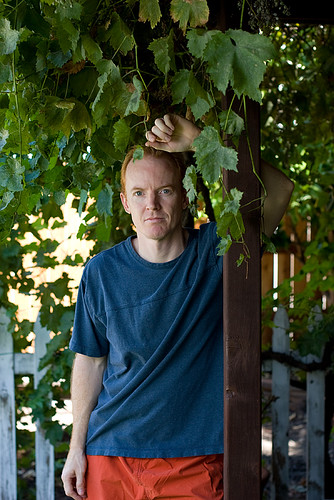
Next I added a backlight to camera left and behind me. This is an old Nikon SB-26 set on optical slave mode. I stuck it up real high and fired it into the grape leaves. It triggers automatically when it detects the main light going off.
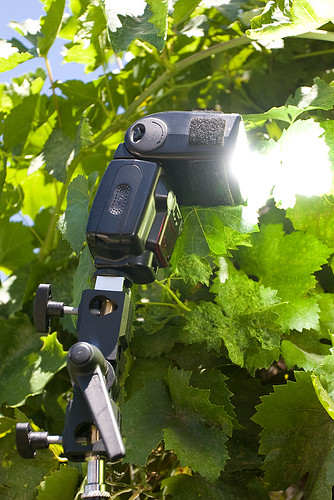
This gave some interest to the background to the left.
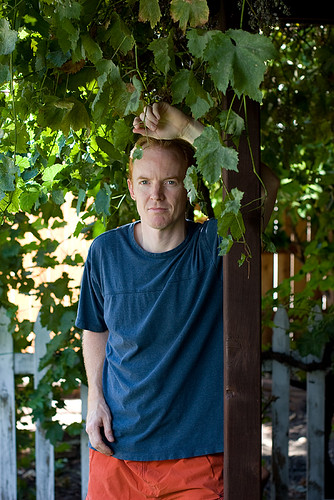
I figured what the heck, and added another light low and behind me to camera right firing up. This is an old Nikon SB-24. It doesn't have a built in optical slave, so I plugged a wein peanut into to. The peanut is an external optical slave that will trigger the flash when it detects the main light going off.
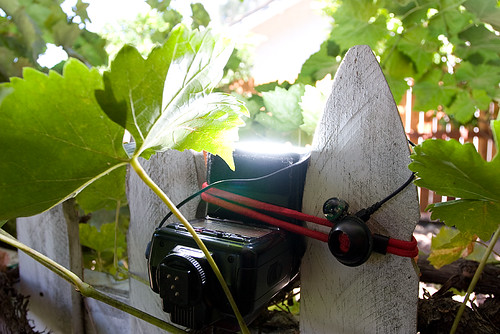
It looks a little overdone to the right in this shot, but I hadn't tweaked it down yet.
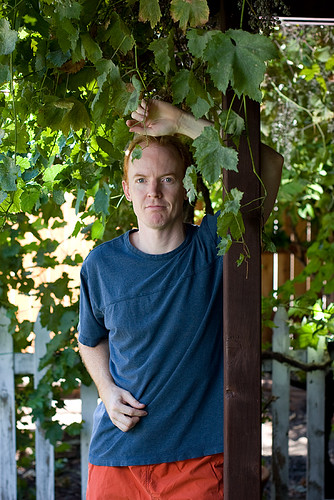
Finally I swapped lenses to my 85mm, and took the shot I had been planning on. I loved the interesting dynamic lighting. The foliage came to life with the strobe hitting at different angles, and once I tweaked them just how I wanted them I pulled off a bit of rim lighting on my right shoulder and left chin as well. All the same, it's subtle. At first glance it doesn't scream "artificially lit", and good lighting shouldn't.
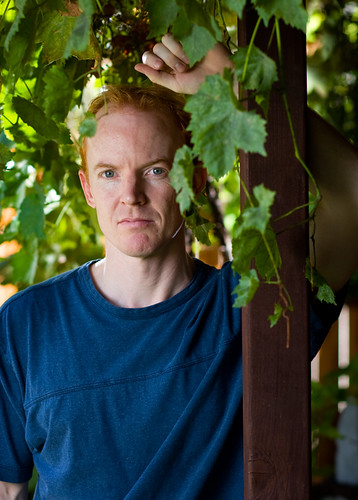
Here's a couple of other shot of the whole setup:
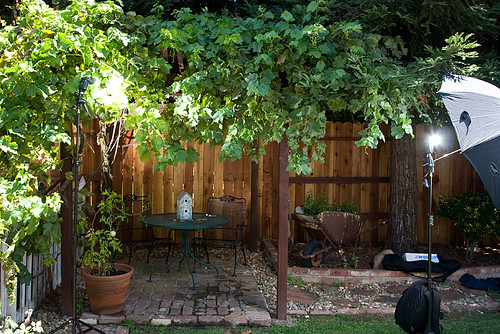
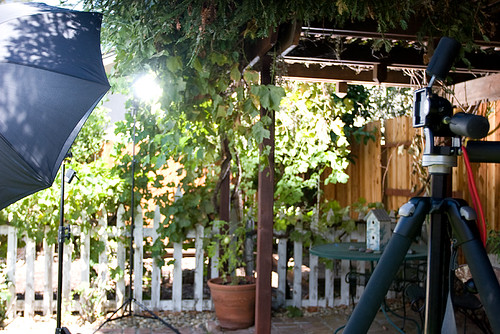
And one more shot of that beautiful Elinchrom receiver hanging from my main light. I had perfect firing results throughout my little project. I can't say how much that rocks after dealing with the cheapie Chinese triggers off of ebay.


7 comments:
I agree with you my friend, light is light and you did an excellent job with it.. the only thing is a bit a problem for me is the set up outdoors.. because if not in a controlled environment, it will never be this same again. You can set it up
a 100 times, and the ratios won't be the same one day than the other, so to me is a kind of a guess/measure it adjust situation.. and the purpose of shooting inside in a controlled area is to minimize that to a zero degree if possible. You can't control natural light.. it is there and it will contaminate your shot every single time. in a cloudy sunny day even worse! Don't get me wrong I think it's great but impracticable in many situations were you need both and have to be quick and instantaneous.
For a fashion shoot outdoors, actually a very good thing, for an event almost useless.. unless you have the three or more extra people who knows exactly how to do it to help you out and even then...
I think it looks great! Thanks for laying it all out this way.
Do you do things like this with your sessions? It seems like it would be awfully time-consuming to do multiple setups, rearranging things while the client stands around.
@anon - Certainly it would be very difficult to reproduce a shot exactly in this environment, but I'm not so sure that is necessarily a bad thing.
As Sharkey pointed out, it can be time consuming to setup and get adjusted properly, but it's really not that bad. The most time time is usually spent setting up the stands and attaching the strobes and light modifiers. Losing the sync cord and incorporating the radio trigger helped this process immensely.
I do use my portable lighting for some sessions. Typically I shoot a lot of natural light shots, bringing in a little strobe light just here and there when necessary, then pick out one particular area to set up for more controlled lighting (typically somewhere with lots shade and a background that is easy to control).
Here's one example from a recent session where I set up the portable softbox in a park. Simple one light setup, so it was pretty quick.
http://www.flickr.com/photos/januaryphotography/2619786861/
Thanks for the comments!
Great post. I heard a comment on Good Eats (the cooking show with Alton Brown) the other day, "To substitute something, you have to understand the thing that you're replacing." I had to stop the show to get that down. :)
I have to say, I've been sort of working backwards with my lighting. I understand and see natural light far better now that I've been playing with making my own. Now I can see soft and hard light and the color of ambient light much more clearly. I understand why it looks the way it does.
That's a great quote!
I totally agree with you too about learning one kind of lighting helping with the other. It makes sense too, since it's all light really. The bare sun is much like a straight on strobe. Hard light. Stand next to a big concrete wall though, and you've got an instant huge softbox.
very informative post! thanks for going to the trouble and sharing your elaborate setup. you made a very strong point. I'm a natural light kinda gal--but not adamant about it. I just don't like carrying around the extra gear. And I like that quote from Alton Brown--very fitting!
hey randy,
just thought of you and your family so i'm dropping by to say hi and hope that all is well.
take care and send my regards to your lovely wife too!
Post a Comment